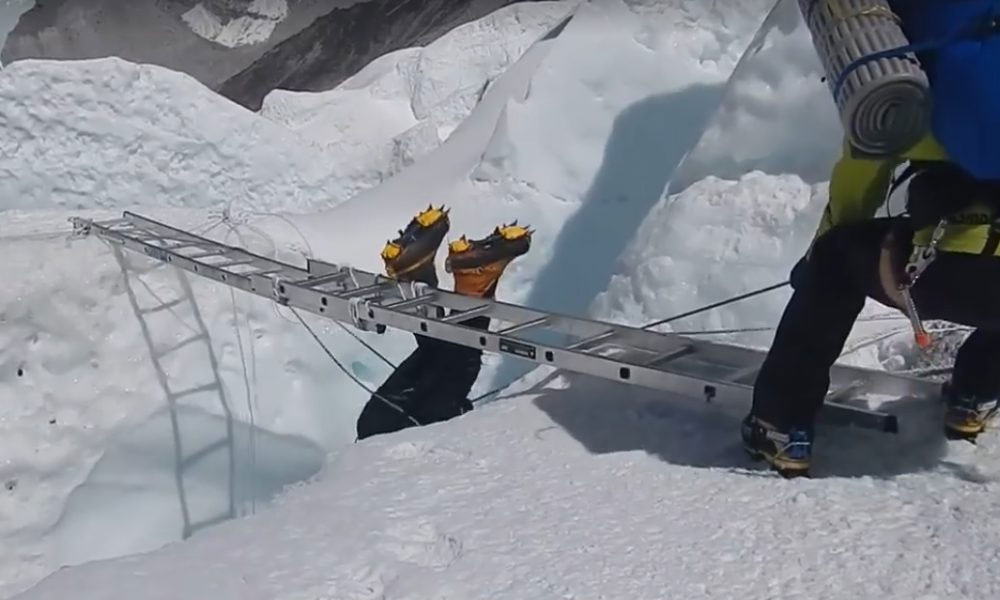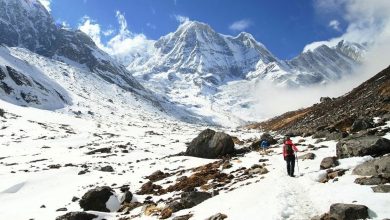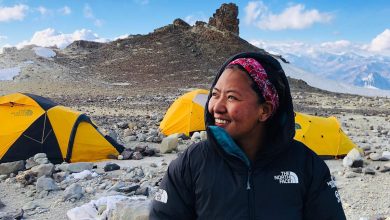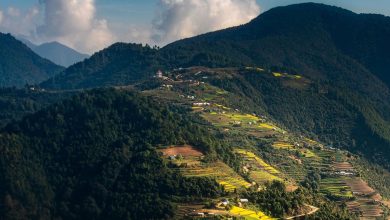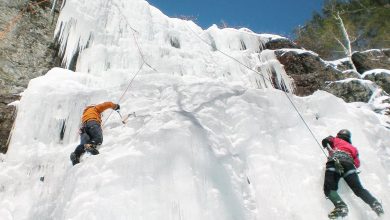Khumbu Icefall – The Head Of Khumbu Glacier

Khumbu Icefall is a dangerous section en route to Mount Everest. It is made up of huge and tall ice blocks that pose a great threat while climbing the tallest peak in the world. In general, Khumbu Icefall is a huge glacier that is 5 kilometers long and moves steadily all the time. Reports claim the icefall moves 0.9 to 1.2 m (3 to 4 ft) down daily. Similarly, the ice entering the fall meets the base after approximately 4.3 years.
The Khumbu Icefall is one of the popular sections of Mount Everest, as it features iconic ladders allowing climbers to climb through strenuous and huge crevasses.
Location and Geographical Structure
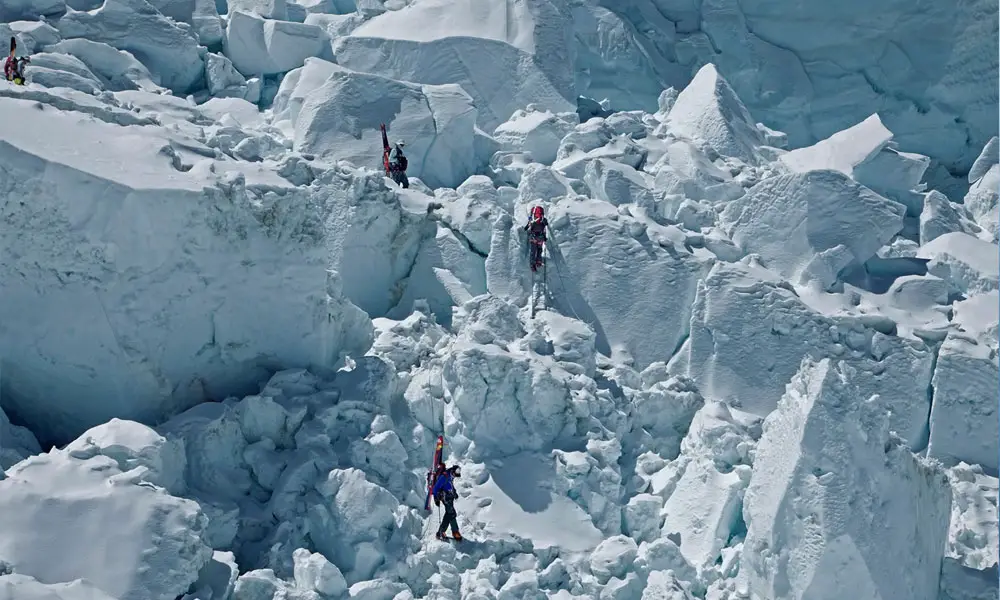
Khumbu Icefall is located at the top of Khumbu Glacier. It is located just below Camp 1 and at the foot of West CWM at an altitude of 5,486 meters (17,999 ft). Similarly, it is not too far from the base camp and the southwest of the summit.
If climbers opt for the South Col. route to Mount Everest, Khumbu Icefall is considered one of the most dangerous sections to traverse.
Difficulty Level of Khumbu Icefall
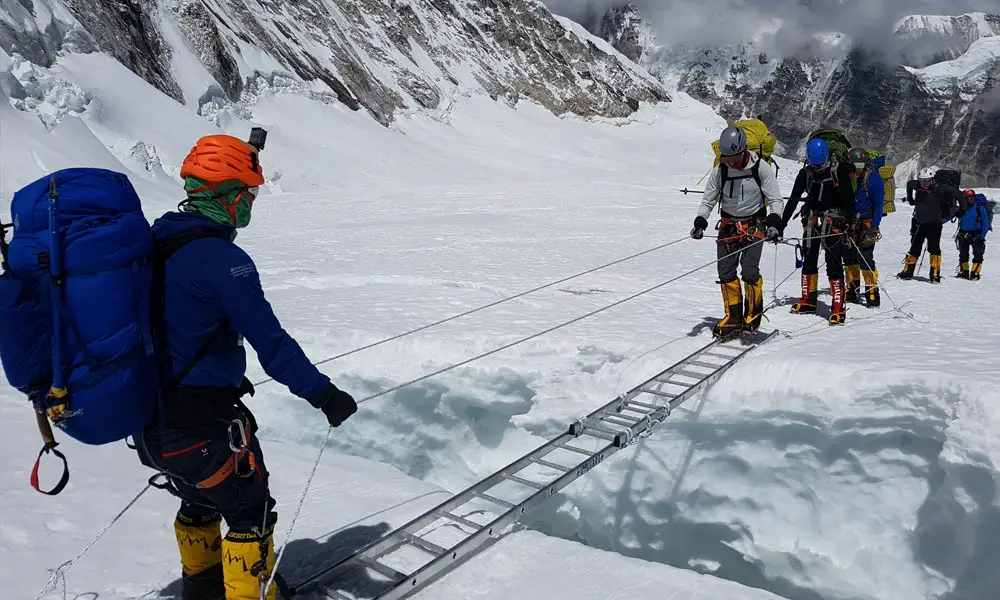
Khumbu Icefall is considered the most dangerous part of Everest. And climbers find it much more challenging than any section while embarking on Everest Expedition.
As mentioned, Khumbu Icefall consists of large and tall ice sheets. And these walls can be up to 150 feet (45m deep). So if climbers do not take proper precautions and gear to climb through this icefall, it is evident that they will meet tragic mishaps or even death.
Climbers must be specialized in technical climbing skills since the Icefall is sloppy and slippery. Specialization in using fixed ropes, setting up ladders, and using axes, crampons, and gaiters are must while traversing through this section.
Why Is Khumbu Icefall So Dangerous?
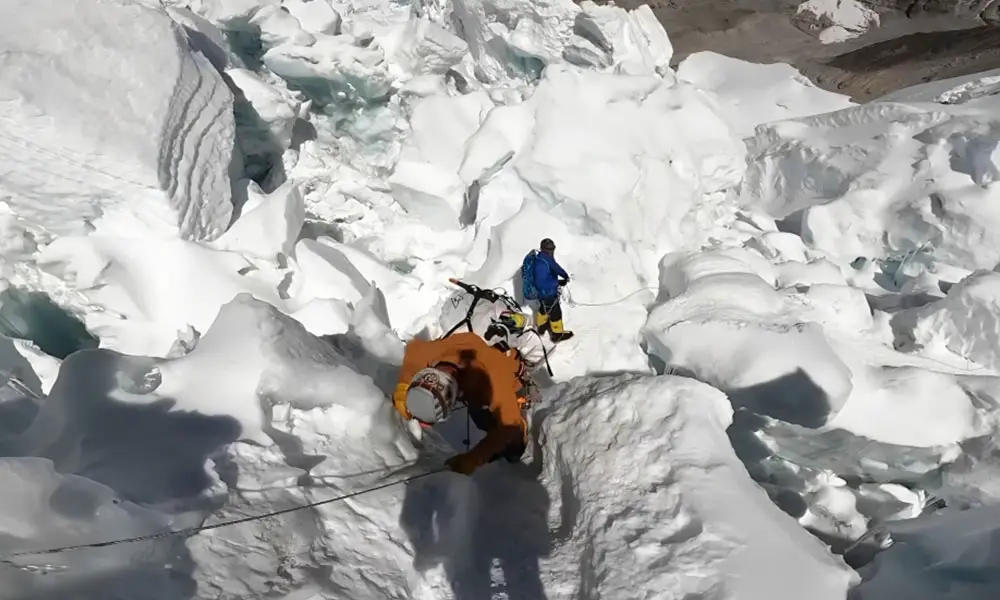
Khumbu Icefall is not considered dangerous for no reason since the region is naturally perilous and can even be life-threatening. While climbers embark on the Everest Expedition, they must be careful of the Khumbu Icefall as they can be very dangerous anytime.
Khumbu Icefall features numerous ice towers called seracs, which can collapse at any time and create several cracks. These cracks are tricky to pass through, and they mostly form in the ice or moving glaciers. Many climbers fall into these seracs, risking their lives.
Another thing to watch out for around Khumbu Icefall is avalanches. Avalanches can occur at any time since the weather conditions around Everest Region is unpredictable. Especially during the winter season, the West Shoulder of Everest and the slopes of Nuptse are prone to avalanches. But during the Everest Expedition, climbers must pass through the Icefall to reach the top of Mount Everest.
If you look at the mountaineering trend, most of the climbers tend to climb through the icefall during the morning time. During this time, the environment gets partially frozen from the cold night, and climbers don’t get into challenging navigation as the ice does not move as much. But during the afternoon, it gets warm, making cracks in ice and chunks of snowfall.
The experience level of climbers, passing through the Khumbu Icefall is easy. But still, several precautions should be taken. But for those who are not frequent climbers and expose themselves to high altitudes once in a blue moon, it might be challenging. While experienced climbers take just a few hours to cross the icefall, it might take more than 10 to 12 hours for inexperienced climbers. Upon successfully crossing Khumbu Icefall, climbers usually camp at the Camp I of Mount Everest.
There are several other risks associated with climbing through Khumbu Icefall – Ice falls are one of them. Huge chunks of ice might fall near climbers while they attempt to cross this section. Getting hit by ice blocks will lead you to suffer from injury or even death.
Moreover, the big ice movement also called an avalanche, impacts the wide array of climbers, including their life and property. Since Khumbu Icefall is prone to avalanches, it might be very challenging to get away from it. Climbers must be prepared and well-trained to get stuck under heavy ice blocks. In case of emergency, they must have skills to rescue others who are in trouble.
Overall, the Khumbu Icefall is one of the most dangerous places to pass while climbing Everest. The large crevasses, ice falls, avalanches, and extreme weather conditions contribute to the risk level of this section. So, it is an ideal idea to be well prepared with technical climbing skills and be acknowledged with the geographical build of the Khumbu Icefall.
Death Records on Khumbu Icefall | How Many Have Died So Far?
Traversing through the Khumbu Icefall before reaching Camp I of Mount Everest is one of the most dangerous tasks. And with no wonder, the Khumbu Icefall has cost many lives throughout the decades. In 2023 alone, there have been three deaths registered in this section. If you see the records from 1953 to 2023, 47 climbers have lost their lives while attempting to climb Khumbu Icefall.
The timeline between 1953 and 2016 cost the lives of 44 climbers. However, there were not any registered deaths on the Khumbu Icefall between 2017 and 2022.
The most recent deaths at the Khumbu Icefall cost the lives of three seasoned Sherpa climbers; Lakpa Rita Sherpa, Pemba Tenjing Sherpa, and Da Chhiri Sherpa. As per the report, they descended from Camp II when the massive avalanche buried them under the huge ice blocks.
One of the most devastating mishaps occurred on 18 April 2014 when an avalanche in the Khumbu Icefall killed 16 Nepalese climbers. Among them, only 13 bodies were recovered, while three still remain covered under the snow.
2014 Avalanche on Khumbu Icefall
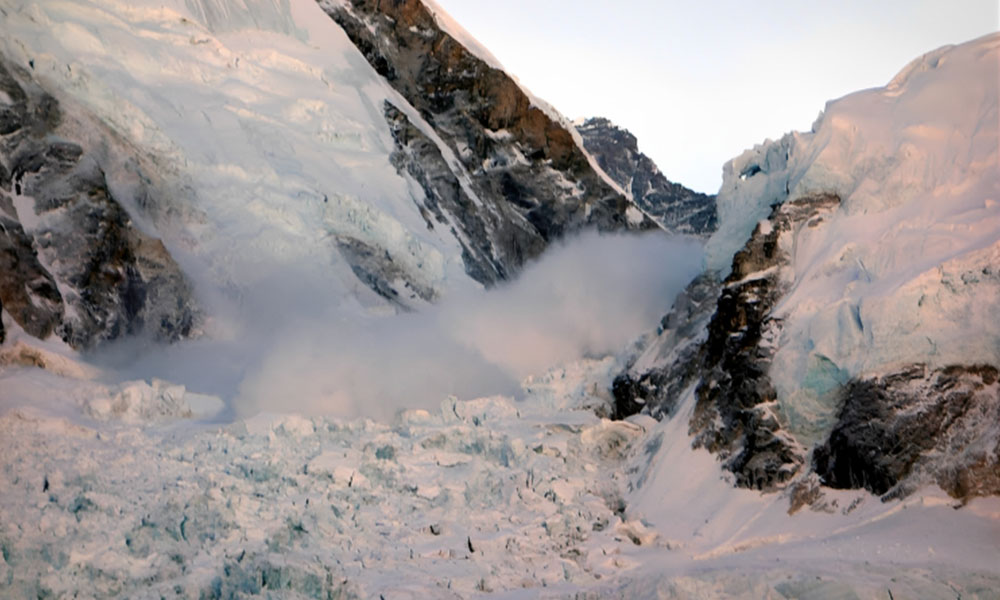
The 2014’s avalanche on Khumbu Icefall was one of the most devastating incidents that has ever occurred on Mount Everest. 16 Nepalese climbers became the victim of the avalanche. Reports cite that the climbers were on the verge of preparing their route through the Khumbu Icefall. Sherpa guides were on the task since the early morning session as they fixed the climbing ropes to guide and safeguard other climbers.
However, the unpredicted avalanche swept all of them, creating a chaotic and extremely dangerous situation. The incident happened between the section of Everest Base Camp and Camp 1. Though the climbing session was launched in Spring, the unpredicted weather conditions played a huge role in the burst of avalanches.
As a result, all 16 climbers died buried under the huge mass of ice and snow. Rescuers were able to recover 13 bodies out of 16 climbers.
Preparations Needed for Khumbu Icefall
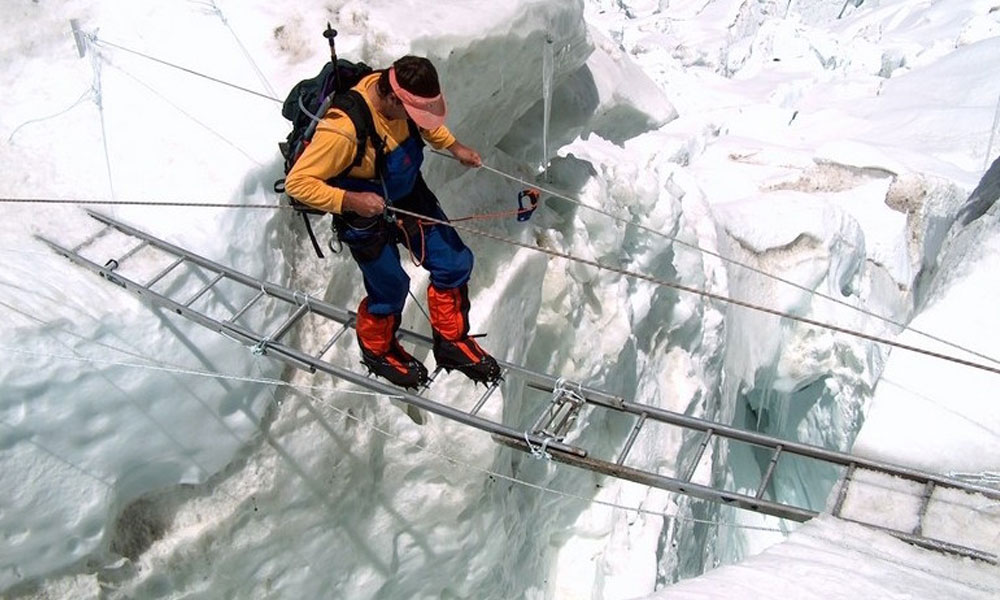
Everest Expedition is challenging, and several regions around the route make it more challenging. Several sections, like Hillary Step, Balcony, and Khumbu Icefall, contribute to the difficulty of the Everest Expedition. Despite being on the lower section of the mountain, Khumbu Icefall is one of the scariest parts to climb during the expedition. It is one of the most dangerous parts of the South Col. Route. Since the Khumbu Icefall has no easy landscape, climbers must be well-prepared for a safe and proper climb. Here are some aspects where climbers must prepare well enough to traverse through Khumbu Icefall:
Physical Fitness: The Khumbu Icefall is a steep, slippery landscape with blue ice and thick snow. So to traverse through it, the climber’s physical fitness matters more than others. Climbing Khumbu Icefall requires high cardiovascular energy, strength, flexibility, and stamina. Another major focus point is high-altitude, which can pose a risk of altitude sickness and respiratory hazards. So before embarking on the Everest Expeditions, climbers must be prepared for their overall physical well-being.
Technical Skills: There are treacherous and sloppy landscapes that demand high technical climbing skills in Khumbu Icefall. Techniques like ice and rock climbing, crevasse rescue, rope work, gaiter, axes, and crampons settings are necessary. Overall, climbers must have advanced mountaineering training, which helps them to know the diverse landscapes of the mountains and the difficulty they come with.
Altitude Acclimatization: Acclimatization is one of the key procedures to stay safe in higher altitudes like Khumbu Icefall, which lies above 5500 meters above sea level. Climbers must plan a gradual ascent to higher altitudes to adapt the body to reduced oxygen levels. It is important to know that climbers must not expose themselves to higher altitudes for a long time, or they can suffer from altitude sickness and other related illnesses, including HACE, HAPE, and AMS. Moreover, hydration, nutrition, and enough rest also should in the priority list.
Gear and Equipment: Climbing Mount Everest via Khumbu Icefall is not just trekking, so climbers should have a set of premium and professional mountaineering gear. Items like crampons, ice axes, harnesses, helmets, ropes, and clothing rated good for extremely cold temperatures should be on your packing list. Before embarking on the expedition and reaching Khumbu Icefall, ensure your equipment is in good condition.
Hiring Experienced Guides: Climbers should always seek help from professional and experienced guides, so their expeditions will be more safe and secure. Whether it’s fixing the climbing ropes or acting to rescue the injured climbers, professional guides can help and provide valuable insights to ensure your safety during the climb.
While the Khumbu Icefall demands a high level of physical and technical sides of mountaineering, guides with extensive knowledge and experience will always be a helping hand.
Weather Forecast: There have already been several mishaps in the Khumbu Icefall due to extreme weather, such as the 2014’s massive avalanche. It is also an alarm for other climbers to look for the weather forecast before launching their Everest Expedition. Three Sherpas lost their lives in an avalanche just a few months ago – it shows how going through weather forecasts plays a vital role.
If the weather is bad, you can always postpone your climb.
Team Communication: Another major thing to focus on while climbing Everest via Khumbu Fall is having strong team communication. All climbers must establish clear and effective communication with other team members and guides to build good coordination and safety during the climb. While Khumbu Icefall is most challenging, having communication for help and support is essential.
Rescue Plan: As mentioned above regarding the preparation of climbers in rescue activities, it comes to light how dangerous Khumbu Icefall is. Since the weather condition around Khumbu Icefall is unpredictable, anything can happen anytime. Most of the time, experienced Sherpas come to the limelight to rescue climbers from the crevasses of Khumbu Icefall and Glacier. But we suggest every climber must have the rescue plan and skills to stay safe and support their team. They must know the location of nearby medical facilities and communication methods.
You may also like:
- How Much Does It Cost To Climb Mount Everest?
- Easiest 8000 Meter Peak To Climb in Nepal
- How Hard Is It To Climb Mount Everest?
- The First Ever Deaths In Everest in 2023
Frequently Asked Questions
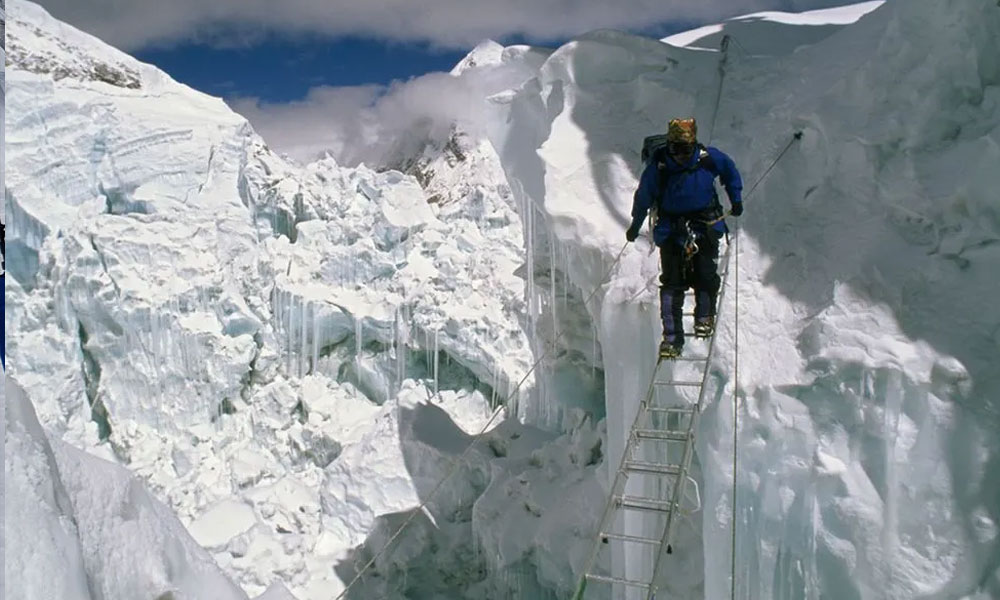
What are the dangers featured by the Khumbu Icefall?
The Khumbu Icefall features several dangerous aspects, such as constantly shifting ice seracs, deep crevasses, and towering ice formations.
How high is the Khumbu Icefall?
Khumbu Icefall sits at an altitude of 5,486 meters (17,999 ft). It is location climbers traverse through after starting their expedition from the Base Camp via the South Col. route.
Is climbing the Khumbu Icefall technically challenging?
Yes, climbing the Khumbu Icefall is a technical challenge. Climbers must have skills of ladder settings over crevasses, climbing steep ice walls, and using fixed ropes.
Can climbers bypass the Khumbu Icefall?
The Khumbu Icefall is an unavoidable part of the South Col. route. Until and unless you are climbing from the North Face, all climbers attempting this route must traverse the icefall.
How long does it take to cross the Khumbu Icefall?
The average duration to cross the Khumbu Icefall is around 6 to 8 Hours, which is for experienced climbers. But for intermediate climbers, it might take up to 10 to 12 hours.
What time of the day is the best time to attempt crossing the Khumbu Icefall?
Most of the climbers prefer crossing the Khumbu Icefall early in the morning when the ice is still frozen. If you attempt crossing during the afternoon, it might be too much slippery and wet that can hamper your navigation.
